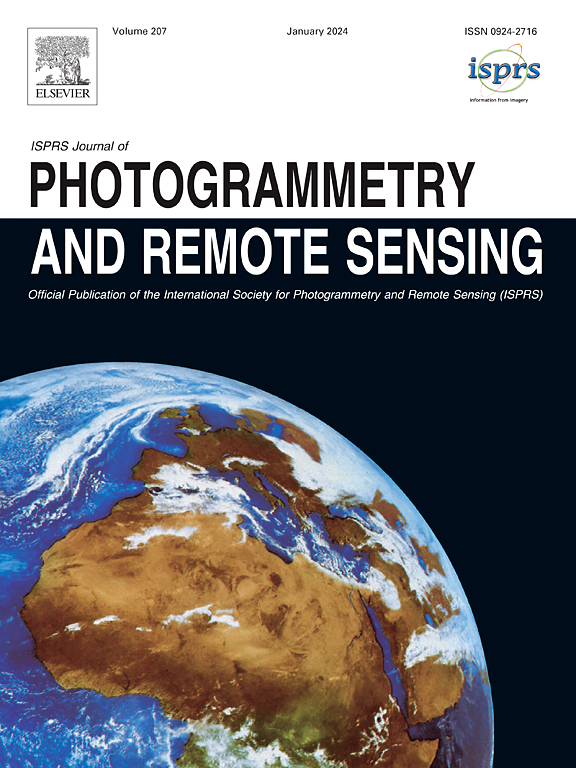SpecDETR:基于变压器的高光谱点目标检测网络
IF 10.6
1区 地球科学
Q1 GEOGRAPHY, PHYSICAL
ISPRS Journal of Photogrammetry and Remote Sensing
Pub Date : 2025-05-25
DOI:10.1016/j.isprsjprs.2025.05.005
引用次数: 0
摘要
高光谱目标检测(Hyperspectral target detection, HTD)旨在根据高光谱图像中的光谱信息识别特定的物质,可以检测到极小尺寸的物体,其中一些物体的面积小于1像素。然而,现有的HTD方法是基于每像素的二值分类,忽略了高光谱图像(hsi)的空间和光谱维度相结合的三维立方体结构。hsi中空间和光谱特征的协同存在使目标能够同时表现这两种特征,但逐像素HTD框架限制了这些特征的联合表达。本文从空间-光谱协同表示的角度对HTD进行重新思考,提出了一种创新的高光谱点目标检测任务框架。我们介绍了SpecDETR,这是第一个用于高光谱多类点目标检测的专用网络,它消除了对基于视觉的目标检测器通常需要的预训练骨干网络的依赖。SpecDETR使用多层变压器编码器和自激发亚像素级关注模块,直接从高光谱立方体中提取深度空间-光谱联合特征。在特征提取过程中,我们引入自激机制,通过自激放大来增强目标特征,从而加快网络收敛速度。此外,SpecDETR将点目标检测视为一对多集预测问题,从而实现了超越最先进的(SOTA) DETR解码器的简洁高效的DETR解码器。我们开发了一个模拟的高光谱点目标检测基准,称为SPOD,并首次评估和比较了视觉目标检测网络和HTD方法在高光谱点目标检测上的性能。大量的实验表明,我们提出的SpecDETR优于SOTA视觉目标检测网络和HTD方法。我们的代码和数据集可在https://github.com/ZhaoxuLi123/SpecDETR上获得。本文章由计算机程序翻译,如有差异,请以英文原文为准。
SpecDETR: A transformer-based hyperspectral point object detection network
Hyperspectral target detection (HTD) aims to identify specific materials based on spectral information in hyperspectral imagery and can detect extremely small-sized objects, some of which occupy a smaller than one-pixel area. However, existing HTD methods are developed based on per-pixel binary classification, neglecting the three-dimensional cube structure of hyperspectral images (HSIs) that integrates both spatial and spectral dimensions. The synergistic existence of spatial and spectral features in HSIs enable objects to simultaneously exhibit both, yet the per-pixel HTD framework limits the joint expression of these features. In this paper, we rethink HTD from the perspective of spatial–spectral synergistic representation and propose hyperspectral point object detection as an innovative task framework. We introduce SpecDETR, the first specialized network for hyperspectral multi-class point object detection, which eliminates dependence on pre-trained backbone networks commonly required by vision-based object detectors. SpecDETR uses a multi-layer Transformer encoder with self-excited subpixel-scale attention modules to directly extract deep spatial–spectral joint features from hyperspectral cubes. During feature extraction, we introduce a self-excited mechanism to enhance object features through self-excited amplification, thereby accelerating network convergence. Additionally, SpecDETR regards point object detection as a one-to-many set prediction problem, thereby achieving a concise and efficient DETR decoder that surpasses the state-of-the-art (SOTA) DETR decoder. We develop a simulated hyperSpectral Point Object Detection benchmark termed SPOD, and for the first time, evaluate and compare the performance of visual object detection networks and HTD methods on hyperspectral point object detection. Extensive experiments demonstrate that our proposed SpecDETR outperforms SOTA visual object detection networks and HTD methods. Our code and dataset are available at https://github.com/ZhaoxuLi123/SpecDETR.
求助全文
通过发布文献求助,成功后即可免费获取论文全文。
去求助
来源期刊

ISPRS Journal of Photogrammetry and Remote Sensing
工程技术-成像科学与照相技术
CiteScore
21.00
自引率
6.30%
发文量
273
审稿时长
40 days
期刊介绍:
The ISPRS Journal of Photogrammetry and Remote Sensing (P&RS) serves as the official journal of the International Society for Photogrammetry and Remote Sensing (ISPRS). It acts as a platform for scientists and professionals worldwide who are involved in various disciplines that utilize photogrammetry, remote sensing, spatial information systems, computer vision, and related fields. The journal aims to facilitate communication and dissemination of advancements in these disciplines, while also acting as a comprehensive source of reference and archive.
P&RS endeavors to publish high-quality, peer-reviewed research papers that are preferably original and have not been published before. These papers can cover scientific/research, technological development, or application/practical aspects. Additionally, the journal welcomes papers that are based on presentations from ISPRS meetings, as long as they are considered significant contributions to the aforementioned fields.
In particular, P&RS encourages the submission of papers that are of broad scientific interest, showcase innovative applications (especially in emerging fields), have an interdisciplinary focus, discuss topics that have received limited attention in P&RS or related journals, or explore new directions in scientific or professional realms. It is preferred that theoretical papers include practical applications, while papers focusing on systems and applications should include a theoretical background.
 求助内容:
求助内容: 应助结果提醒方式:
应助结果提醒方式:


